United States Armed Forces
The Armed Forces of the United States (official English designation: United States Armed Forces, unofficially usually US Military) are the military of the United States of America, a central instrument of the foreign policy of the United States and of crucial importance for the hegemonic position of the country. They consist of the six branches of the military: US Army, US Air Force, US Navy, US Marine Corps, US Coast Guard and US Space Force. For decades, they have been the best-equipped and second-largest military force in terms of personnel after the People's Liberation Army of the People's Republic of China.
The six branches of the armed forces consist of over 1.28 million active soldiers and almost 860 thousand reservists, which can be supplemented by the paramilitary-oriented US Coast Guard and National Guard in the event of war. In addition, they have about 745,000 civilian personnel. The Commander-in-Chief is the President of the United States, while Democratic control is exercised by the two chambers in Congress. The oldest branch of the armed forces is the Army, which was established in 1775, while the newest is the Space Force, which was established in 2019. In addition to these forces, some states have also established their own military units, called state guards, which report exclusively to their respective governors.
According to widespread external assessment, American self-portrayal and political science consensus, the US armed forces are the most powerful in the world. This clout is based on the largest military budget in the world by far and continues to be so, from which the most extensive shares flow into reconnaissance, information flow, networking, equipment and research. The budget is $580 billion in fiscal year 2016 for core missions, plus $218 billion to $262 billion for nuclear weapons maintenance, veterans care, and other expenses. Technical innovations and personnel development activities in the United States military are leading the way for partners in NATO, of which the United States is a leading member, and other allies.
Organizationally, the armed forces underwent a transformation from a localized English-style militia, centralized through recurring instances of conscription, to a professional army, and today exhibit characteristics of all three of these recruitment methods. The strength of the United States military has always been oriented toward the importance the United States attaches to itself in foreign policy, so that armed forces and diplomacy have undergone a parallel evolution. Thus, both through dozens of interventions abroad and through its deterrent effect on the outside world, the military has been partly responsible for the country's rise to superpower status and for maintaining that status beyond the Cold War. In addition to the global disintegration of state structures, the United States' military advantage has fostered the emergence of asymmetric forms of combat that pose strategic challenges to U.S. forces.
History
→ Main article: Military history of the United States
Before and during the founding of the United States, quasi-military groupings of poorly trained militias arose under the command of the states. A resolution of the Continental Congress provided for the creation of a Continental Army in which these would be combined. This force, with considerable support from France, won the War of Independence under the command of George Washington, but was subsequently disbanded in adherence to the ideals of the Revolution.
In time, the need for a standing army as well as a navy became apparent. The ordering of several frigates in 1794 was the de facto birth of the U.S. Navy. The Army once again combined the disorganized and poorly trained contingents of the State militias to pool their strengths and clean up their weaknesses.
Between the founding of the United States and the Civil War, American forces won the American-Tripolitan War on the North African coast, failed to prevail in the British-American War, but enabled the territorial expansion of the United States to the Southwest. At the beginning of the Civil War, several units became part of the Confederate military, including some of the most able generals. The war cost the lives of 600,000 people and lasted four years before the Union army won the final victory.
In the period between the Civil War and the 1890s, the importance of the military declined, even as Army units fought Indians in the course of the steady westward expansion of the United States. By the turn of the century, however, this trend was reversed as the fullness of the United States' power began to increase, necessitating the final legal separation of police and military powers. The Army fought in the Spanish-American War and in the Philippines in 1898. Also to be added are dozens of interventions under the Monroe Doctrine in Latin America and the dispatch of the Great White Fleet by President Theodore Roosevelt to demonstrate the new national self-confidence. The Militia Act of 1903 established the National Guard.
In April 1917, in response to the German Empire's rampant unrestricted submarine warfare, the United States entered World War I as an associated power alongside the Entente. The United States supported its allies with massive amounts of supplies, relieved them by sending a million-man expeditionary force to Europe, and thus made a decisive contribution to the defeat of the Central Powers. Due to the isolationism that prevailed in the interwar period, the U.S. military, especially its land forces, was greatly reduced, but in part expanded again in the run-up to World War II.
As a result of the Japanese attack on Pearl Harbor, the United States initially entered the war against Japan in December 1941, and shortly thereafter the two Axis powers, Germany and Italy, declared war on the United States. In the confrontation with Nazi Germany, the armed forces participated in the reconquest of large parts of North Africa, Italy, and Western Europe, establishing, as in World War I, a superiority in weapons, troops, and supplies that enabled the Allies to defeat the German Reich. This was the only way, for example, that the Western Allies were able to open a second front in the large-scale, successful Normandy landings. In the Pacific they pushed back the troops of the Japanese Empire almost without foreign support in a laborious so-called "Island Hopping". The United States forced the Japanese surrender by using twoatomic bombs, which they were the first nation in the world to possess since 1945 (Manhattan Project), in order to avoid a loss-making invasion of the main Japanese islands.
Already in the final phase of World War II, the impending tensions of the Cold War were looming. The statist tendency of United States society, which had made downsizing the military a matter of course after the end of major wars, gave way to fears of the spread of communism, so American troops were stationed abroad in large numbers.
Over a period of 40 years, the National Security Act, passed in 1947, was to represent the most far-reaching military reform. Many agencies and units that had been established in the just-concluded global conflict with the proviso of functioning as expeditiously as possible were eventually merged or reformed. Whereas air units had been part of the Army during World War II, the Act placed them on an equal footing with the other armed forces under the umbrella of the United States Air Force. Moreover, the most important innovation was the creation of a central foreign intelligence service, which was to be assisted by a whole network of intelligence agencies with special competencies in the course of the Cold War. The law also included the creation of cross-force general staffs and ministries.
With the advent of the Cold War, a debate over force strategy ignited. Senior Air Force officers relied on nuclear weapons as conventional offensive assets and called for massive spending on strategic bombers. In contrast, the Navy pointed to the successes of naval dominance in World War II. The cancellation of an ordered aircraft carrier by Secretary of Defense Louis A. Johnson, who favored air power, led to the admirals' revolt.
In fact, both branches of the armed forces remained predominantly equal during the Cold War, although strategic initiative in the air became an increasingly important moment in American and Western military doctrine. The United States Air Forces in Europe (USAFE) made a major contribution to deterring the Soviet Union and, because of Europe's geostrategic location, became a central hub of American military operations around the world. At the height of their strength, 60,000 airmen were under the command of the USAFE.
Although there was no direct confrontation with the Soviet Union, American soldiers fought in several proxy wars between the two power blocs. While the three-year Korean War, as a result of which a significant portion of U.S. forces were stationed in South Korea, was almost forgotten collectively for lack of a successful conclusion, the Vietnam War, which was ultimately lost, caused far-reaching military and social changes. The U.S. had failed to defend the Republic of South Vietnam against the attacks of the northern part of the country, which was communist. The most drastic example was the suspension of conscription in 1973. For almost two decades, the trauma of the war in Southeast Asia prevented major operations by the US military.
In the 1980s, American troops fought in Operations Just Cause in Panama and Urgent Fury in Grenada. In Lebanon, the death of 239 Marines and the subsequent withdrawal of foreign troops established the beginning of the civil war there. The Goldwater-Nichols Act of 1986 reorganized the military and successfully ended rampant rivalries between the armed forces. After the collapse of the Soviet Union, cutbacks, rationalizations, and base closures set in. Still, the U.S. military contested deployments. The liberation of Kuwait in alliance with nearly 30 other countries, resulting in the complete destruction of Iraq's forces in four days with minimal coalition losses, demonstrated the military supremacy of the United States. U.S. forces initially wore down Iraqi units through weeks of airstrikes, with a deployment of ground forces only occurring when strong resistance was no longer expected. The operation in Somalia experimented with the use of military units to stabilize weak nation states or to establish nation states capable of acting. However, it ended with defeat in the Battle of Mogadishu, which confronted the U.S. military with the tactics of guerrillas in urban areas. In addition, the U.S. military intervened in several smaller operations such as Kosovo and Haiti.
The terrorist attacks of September 11, 2001, prompted a strategic reorientation, reflected, for example, in the transformation of the US Army and the cancellation of the Comanche program. The defense budget rose to unprecedented levels after the Cold War. The United States invaded Afghanistan as late as 2001 and Iraq in March 2003. The war against Iraq was also waged under the pretext of fighting terrorism, but it later turned out that Saddam Hussein's regime had no ties to Osama bin Laden, nor were any chemical agents found that would have posed a threat to the region. While the campaigns have been militarily successful, pacifying the areas of operations has proved difficult. Since late 2008, the battlefield has shifted from Iraq back to Afghanistan, which, like the Korean War, has been dubbed the "Forgotten War." The strategy of cooperation with locals and the planned expulsion of insurgents from their retreat areas, once successfully applied in Iraq, had not yet led to success in the strategically difficult-to-control mountainous region of Afghanistan. Rather, the battlefield has now expanded to include border regions in Pakistan, where U.S. forces have already conducted several operations, including with remote-controlled drones. Due to the difficulty in distinguishing between Taliban, insurgents and local groups, incidents continue to occur, resulting in casualties of uninvolved civilians. Meanwhile, both deployments have lasted longer than the American involvement in World War II.
War victims
Fallen
In absolute numbers, World War II, the War of Secession, World War I, and the Vietnam War were the United States' highest-loss wars. In these wars, 292,131, 184,594 (both Civil War parties combined), 53,513, and 47,369 American soldiers, respectively, were killed by direct enemy action.
When other causes of death, such as epidemics, mortal wounds, frostbite, or friendly fire are added, the highest death rate was in the War of Secession, in which 600,000 more American soldiers died than in all other U.S. wars combined. About 4.8% of the total number of soldiers deployed did not survive the war.
The War of Independence and the war against Mexico were marked by similar hardship in terms of casualties, with 4435 and 1733 soldiers respectively, 2.2% of the troops killed in action. Proportionately, this was more than the 1.8% of the troops who fell in World War II, but the absolute numbers were considerably higher there, averaging 6700 men per month.
Wounded
In percentage terms, there has been a decline in the number of wounded in wars with American participation since the beginning of the 20th century. In the Mexican-American War and the Civil War, a quarter of the troops were lost to wounds, and in the case of the Southern states, nearly a third. All other major wars, including World War II, caused wounding rates between 5% and 7%. After that, Korea and Vietnam decreased the rate to 2.4%. After the Vietnam War, the wounding rate dropped to unprecedented levels. This trend can be explained by general developments in medical technology and the deliberately increased effort of the US armed forces with regard to troop care, which in turn is rooted in the professionalization of the military.
The risk of an American soldier being killed in action or dying from battle-related injuries fell to an all-time low during the occupation of Iraq, although the predominantly urban battlefield made it difficult to medically evacuate soldiers. Underlying this trend is the development of so-called Forward Surgical Teams (German, roughly: "vorgelagerte chirurgische Behandlungsgruppe"). These are mobile and comprehensively equipped medical teams on alert, which can provide full outpatient medical care until the wounded are hospitalized. These treatment teams, which also operate in the field, have increased the likelihood of surviving a wound from 75% in the Vietnam War to 90% by the end of 2004.
Missing
The search for missing soldiers from all branches of the armed forces is the task of the Joint POW/MIA Accounting Command, a working group of the Defense Prisoner of War/Missing Personnel Office within the Department of Defense. Since March 2011, the Joint POW/MIA Accounting Command has been cooperating with the Russian Federation in its role as the successor state of the Soviet Union in a committee.
Since 1945, approximately 83,900 American servicemen have been considered missing in action worldwide, with nearly 74,000 of those missing in action as a result of World War II. With the increasing downsizing and professionalization of the armed forces, accompanied by rising expectations of troop welfare as well as the expanded diplomatic, logistical and technical possibilities for clarifying the whereabouts of so-called MIAs (Missing in Action), these numbers fell to a few thousand for each of the conflicts after World War II: to 8,000 for the Korean War and 1,600 for the Vietnam War. Although individual cases from the Second Gulf War, for example that of the pilot Scott Speicher, received a great deal of public attention, according to official statistics no missing persons from this war remain.
War Crimes
See also:
- War Crimes by the United States in World War II
- War crimes committed by the United States during the occupation of Iraq
United States soldiers committed war crimes in several armed conflicts, which became public due to the increasing media treatment of the war as well as against the proclaimed claim of the US armed forces to fight as "clean" wars as possible. In this regard, the Vietnam War stood out with the MỹLaimassacre. From the Korean War, the Nogeun-ri massacre became well known. Also, during the Iraq War or the occupation of Iraq, increasingly strong allegations were made against US soldiers. Of the confirmed incidents, the Abu Ghuraib torture scandal and the Haditha massacre achieved sad notoriety.
War Costs
Determining the cost of warfare to the United States outside of the ordinary defense budget is difficult because of documents that have been lost in many cases, changes in accounting mechanisms, and inflation that often cannot be reconstructed, and thus cannot be approached with general reliability. Nonetheless, a 2008 congressional report notes that World War II cost $4.1 trillion (June 30, 2008 dollar level) in inflation-adjusted terms, and weighed on U.S. gross national income at the time at a rate of 37.5%. The next largest fiscal burdens on the U.S. prior to the 21st century were the Vietnam War, which consumed $686 billion and nearly 9.5% of gross national income in 1968, and the Korean War, which was funded at $320 billion and took about 14.1% of GNI in 1952. By contrast, the United States' global warfare and security operations since 2001 have cost $859 billion through fiscal year 2008, but are relatively small in 2008, totaling 4.2%.

Victims of the Mỹ-Lai massacre

Missing Man Table as a place of honor for missing and fallen soldiers in a dining hall in Afghanistan.

Commemorative flag for soldiers who are in "Missing In Action" status or prisoners of war.
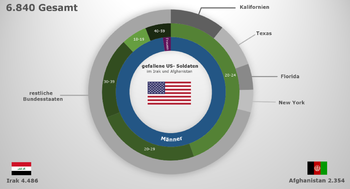
Fallen US soldiers by sex, age and origin
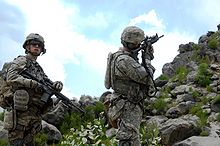
Soldiers in the mountains of Afghanistan

Funeral service for US soldier killed in Iraq
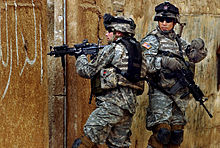
US soldiers in Baghdad
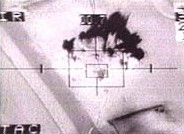
Target acquisition videos presented the Second Gulf War as precisely fought

carpet bombing
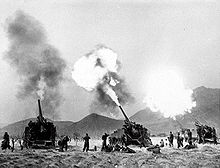
American artillery during the Korean War near Seoul
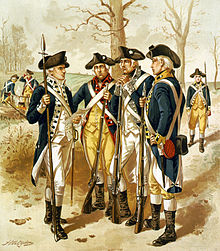
infantrymen of the Continental Army

American soldiers in New York in 1919 after returning home from World War I.
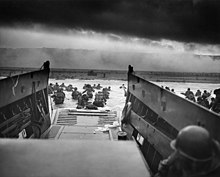
Into the Jaws of Death: Storming of the Omaha beach section during D-Day
Order
Legal definition of the contract
The mission of the United States Armed Forces is to protect the Constitution of the United States, whose core values are republican democratic principles. The content of this protective mission is delineated beyond the Constitution by the War Powers Resolution, a federal statute. The political system of the United States, which primarily expresses the executive-heavy nature of the Constitution, enshrines numerous institutions that advise the President in the exercise of the supreme command.
Constitutional basis
According to Article II, Section 2, Paragraph I, Clause 1 of the Constitution, the President "[...] shall be Commander in Chief of the Army and Fleet of the United States, and of the Militia of the several States, when called out to active Service for the United States[...]." "The right to declare war on [other nations]," however, under Article I, Section 8, Clause 11, is vested only in Congress, which must bless a war by a two-thirds vote of both houses. This sentence is followed by provisions that clarify its financial sovereignty in military matters in particular: According to them, Congress alone determines "to raise and maintain armies; but the appropriation of money therefor shall not be made for more than two years;" (clause 12), "to build and maintain a fleet;" (Clause 13), "to make regulations for the command and service of the land and naval forces;" (Sentence 14).
Although the Philadelphia Convention developed the United States Constitution in the spirit of peaceful human development, the United States military is not by definition committed to international peace and global stability.
Federal Laws
The Constitution is framed in general terms according to the customs of common law, the Anglo-Saxon legal tradition, so that federal law differentiates the responsibility for national defense. The basis of American security and defense policy is the National Security Act of 1947. After the Korean War, presidents moved to declare deployments of the armed forces as police actions, which undermined the legislature's unconditional authority to declare war. Therefore, in 1973, Congress passed the War Powers Resolution by overriding then-President Richard Nixon's veto. It stipulated that the president must notify Congress within 48 hours of the commencement of any warlike action. The deployment must end after 60 days before the president must request an extension for another 30 days. This can be granted by Congress in urgent, exceptional circumstances before having to proceed to a formal declaration of war.
The missions of the Armed Forces are set forth in individual statutes in the 10th Book of the United States Code.
The Posse Comitatus Act precludes federal military deployments domestically as a matter of principle, but does not preclude deployments of the Coast Guard and National Guardsmen closely associated with the Army and Air Force.
Swearing in
All members of the armed forces are sworn to the Constitution. The oath text for officers who have received their commission differs from the oath of all other enlisted soldiers. The current version of the Oath of Enlistment was adopted on May 5, 1960, and reads:
"I, [name of person to be sworn], do solemnly swear [alternatively: affirm] that I will support and defend the Constitution of the United States against all enemies, foreign and domestic; that I will bear true faith and allegiance to the same; and that I will obey the orders of the President of the United States and the orders of the officers appointed over me, according to regulations and the Uniform Code of Military Justice. So help me God. “
- Title 10, US Code
in German:
"I, [name of person to be sworn], do solemnly swear [alternatively: affirm] that I will protect and defend the Constitution of the United States of America against all enemies, foreign and domestic; that I will bear true faith and allegiance to the same; and that I will obey the orders of the President of the United States, and of the officers superior to me under the Uniform Code of Military Justice [note: English term for American military law], so help me God. “
- Tenth Book of United States Federal Law
Civilian control
The division of supreme command over the armed forces on the one hand, and budgetary sovereignty and the right to declare war on the other, to the executive and legislative branches respectively, enabled a long-lasting tradition of civilian control over the army to be established. However, reliable civilian control only began in the 19th century after frequently recurring tensions between politics and the military.
An exemplary precedent for the absolute subordination of the armed forces to the will of politics is George Washington's self-image as a citizen-soldier, which in its basic features goes back to the Anglo-American militia system. Washington defused the threat of the Newburgh Conspiracy toward the end of the Revolutionary War and resigned his commission immediately after the end of hostilities.
After several minor coup attempts, the call by broad sections of the population for a military dictatorship in the face of the threat of Union defeat once again endangered the prevailing relationship between the two institutions. The Democrats, moreover, attempted to field General Ulysses S. Grant, who was still serving, as a presidential candidate in 1863. However, the popular Grant refused to run and was not elected president until he retired in 1868. These precarious conflicts, along with a tendency to criticize the state, always led to a downsizing of the military after wartime engagements until World War II.
In the 20th century, the tradition of civilian control solidified. Critics from the liberal to left-wing spectrum in particular, however, point to the party allegiance of senior officers to the Republicans, which at times was as high as 70 %, and Dwight D. Eisenhower's warning about the possible rise of a military-industrial complex.
Civilian control was normalized by the following regulations:
- The command of the armed forces by civilian officials with the rank of Secretary of State. While the commander of the armed forces is responsible to the Joint Chief of Staff for the deployment of ready troops and thus for training, the Secretary of State is in charge of administration. However, the Secretary of State's signature is required for every measure, even those taken by the military commander, insofar as they concern fundamental regulations, such as organizational changes or lists of proposed promotions.
- The ban on active officers becoming ministers of defence directly after retirement. In principle, a waiting period of seven years is required here. Only by a majority vote of the House of Representatives and the Senate can an exception be granted here. Exceptions were granted in the 21st century for James N. Mattis and Lloyd Austin.
- The Posse Comitatus Act, which generally prohibits and criminalizes police use of federal forces in the interior, with the exception of the Coast Guard. Exceptions could only be granted by Congress or by the President in the context of counterinsurgency under strict legal parameters.
- Ranks of Lieutenant General or Vice Admiral and above shall not be conferred permanently. These ranks or higher may be attained only by nomination to a post. They must be nominated for a specific post by the President and confirmed by a simple majority vote of the Senate. Service in the post is limited in time and does not automatically renew.
Defence institutions and customs
The predominantly general provisions of the Constitution in the tradition of common law mean that, unlike the German Basic Law, it does not mention a single ministry. Except for the restriction that international agreements require ratification by Congress, the president is free to shape foreign policy. Nevertheless, the Secretary of Defense is considered one of the most important cabinet members, which has not yet been omitted by any president.
Since World War II, however, an increasingly ramified network of bodies has emerged from whose expertise the president, secretary of defense, and senior officers can draw. The most important bodies, such as the National Security Council of the United States, came into being largely as a result of the two major reform acts of 1947 or 1986. The political opposition usually tries to influence the formation of opinion on defense policy issues through the committees of the chambers of parliament. In addition, a network of analysts and think tanks has emerged in the United States in recent decades, linked to the military, politics, the media, companies and universities, which has become an integral part of American politics.
In terms of day-to-day policy, the two overarching legislative texts, the Constitution and the War Powers Resolution, derive the United States' seminal National Security Strategy, a doctrine at the intersection of military and political. The armed forces then draw their strategic instructions from the purely military National Defense Strategy, which is subordinate to it. Its importance can be measured by the fact that every president, at the beginning of his term, has to draw up an updated version, which becomes known to the public under his name, for example the so-called Bush Doctrine. The current National Defense Strategy currently focuses on the fight against global terrorism, securing national interests, and resources that are vital to the United States.
The Secretary of Defense, through the National Command Authority in his Department, shares in the President's overall command.

John Trumbull: General George Washington Resigning his Commission, ca. 1817.
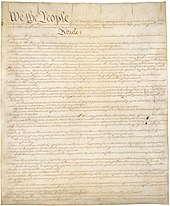
Protective Object and Legitimizing Document of the Armed Forces: The Constitution of the United States
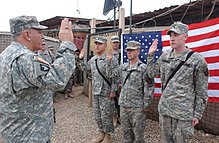
Except for the text, the formalities of swearing in can be varied. Often they take place on the sidelines of sporting events, it is possible to swear small groups.
Search within the encyclopedia